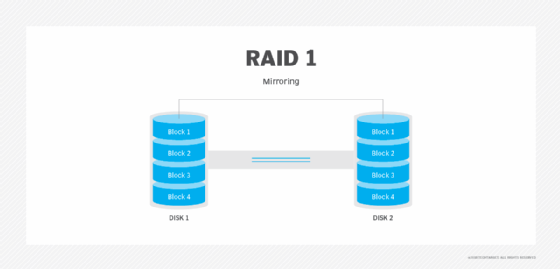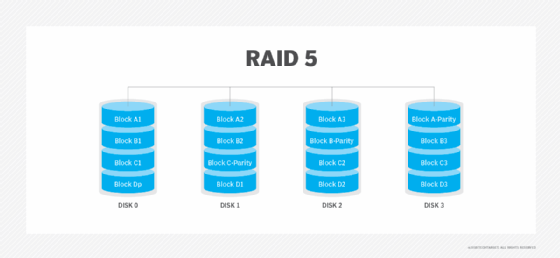
Gorodenkoff - stock.adobe.com
RAID 1 vs. RAID 5
Neither RAID 1 nor RAID 5 is clearly better than the other, but there are several areas to compare the two to find the right option for your organization.
Many organizations rely on RAID to implement redundancy. The type of RAID a company ends up using will depend on its storage requirements, performance goals and budget.
RAID 1 and RAID 5 are both popular choices for adding redundancy to a storage infrastructure. RAID stands for "redundant array of independent disks." As the acronym implies, both RAID 1 and RAID 5 use multiple hard disks, working together, to achieve redundancy. Redundancy is a critical element of data protection; the more copies of data available, the harder it is to lose that data.
RAID 1 and RAID 5 work differently from one another, and each has its advantages and disadvantages. RAID 1 is commonly referred to as disk mirroring. Hard disks are kept in sync with one another so that if a disk were to fail, an exact copy remains. RAID 5 spans or stripes information across multiple disks. However, each disk within the array stores parity alongside its primary data. If a disk within the array were to fail, then this parity information is sufficient to keep the array functional. When the array replaces the failed disk, it can use the parity information to automatically populate the replacement disk.
To decide between RAID 1 vs. RAID 5, storage and backup administrators must consider the following factors: redundancy, number of required disks, cost efficiency, performance, fault tolerance and complexity. Neither RAID 1 nor RAID 5 is objectively superior to the other, but depending on what factors your organization prioritizes, one option might be better suited to your needs.
Redundancy
Both RAID 1 and RAID 5 can continue to function following the failure of a single disk. This makes them equal in terms of redundancy. RAID 1 uses the mirrored copy in place of the failed disk, while RAID 5 uses parity information that is scattered across the disks within the array to make up for the data stored on the failed disk.
Number of required disks
RAID 1 requires a minimum of two disks. One of these disks contains the primary data, and the second acts as an exact copy. It is possible to create RAID 1 arrays containing additional disks, but each additional disk acts as an extra mirror, or copy. If a RAID 1 array contained three disks, you would essentially have three copies of your data.

RAID 5 requires a minimum of three disks, though it can support larger numbers. RAID 5 stripes data across all the disks in the array so that no single disk contains a complete copy of the data. Instead, each disk contains a partial data copy, plus some parity data that provides redundancy for the array.

Cost efficiency
To achieve redundancy, both RAID 1 and RAID 5 sacrifice a significant amount of storage capacity. The cost efficiency of each array is affected by the amount of storage it uses for redundancy.
A RAID 1 array is a mirrored set, so a two-disk RAID 1 array contains two complete data copies. Because of this, 50% of the storage capacity is lost to redundancy. If you were to add an extra disk to the array, that disk would function as an additional data copy, meaning that the amount of lost storage capacity increases to 66%, decreasing the overall efficiency to 33%.
In a RAID 5 array, the amount of capacity that is lost to overhead is equal to the capacity of a single disk. If you have a RAID 5 array consisting of three disks, then the lost storage capacity is equal to about 33%, and the array has 66% storage efficiency. However, if you were to build a RAID 5 array containing five disks, then the amount of capacity lost decreases to 20%, and the storage efficiency increases to 80%. Regardless of the number of disks in the RAID 5 array, the lost storage capacity will always be equal to the capacity of a single disk.
Performance
RAID 1 array performance is typically equal to that of reading from or writing to a single hard disk. The array structure does not provide any sort of performance benefit, but it does not degrade performance either.
A RAID 5 array generally improves read performance because it spreads data across multiple disks, combining the performance characteristics of the disks. The RAID 5 array reads data at a speed that is higher than what any single disk within the array would be able to deliver by itself. However, write performance is typically slower than read performance due to the need for calculating and writing parity data. Even so, a RAID 5 array's write performance will likely exceed that of a RAID 1 array.
Fault tolerance
As mentioned above, both RAID 1 and RAID 5 can sustain the failure of a single disk within the array. A disk failure does not usually affect a RAID 1 array's performance. However, a failed disk can have a very noticeable impact on a RAID 5 array's performance because there will be fewer disks available to read data. When admins replace the failed disk, the array must repopulate it with data. This rebuilding process can also affect the array's performance until the rebuild is complete.
Complexity
RAID 1 is simple to implement, manage and maintain. RAID 5 is slightly more complex because the array requires a larger number of disks. Even so, neither array type is overly complex.
Brien Posey is a 22-time Microsoft MVP and a commercial astronaut candidate. In his more than 30 years in IT, he has served as a lead network engineer for the U.S. Department of Defense and a network administrator for some of the largest insurance companies in America.






